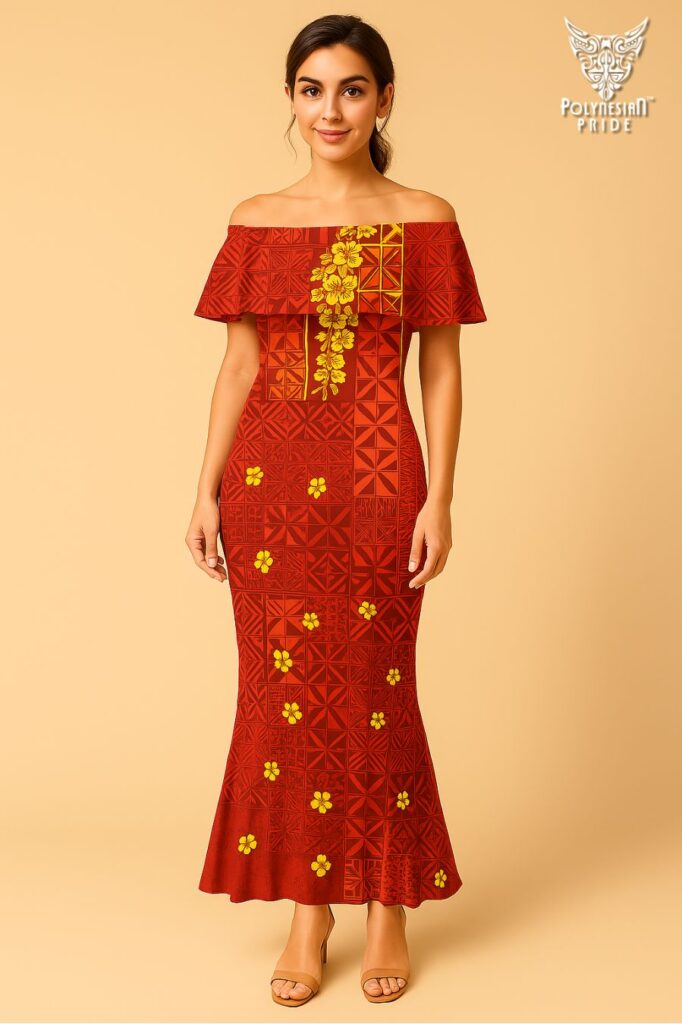Traditional Puletasi Dress: From Samoan Root To Island Trend

INTRODUCTION
The traditional puletasi is a graceful symbol of Samoan heritage, modesty, and womanhood. This two-piece outfit – featuring a tunic and wrap skirt – has been worn by Samoan women for generations, expressing cultural identity with elegance and pride. As a standout example of Samoan traditional clothing, the puletasi is often seen at church gatherings, family events, and even international runways. The Samoan traditional clothing puletasi continues to evolve in design while honoring its deep cultural roots.
This article explores its origins, craftsmanship, cultural relevance, and modern-day transformation, revealing why it remains a timeless emblem of Samoan identity both at home and across the globe.
Explore: Samoa Culture Facts: 17 Things That Make You Mind-Blowing
The Origin of the Traditional Puletasi Dress
Before Colonial Influence
Before the arrival of Europeans, Samoan women wore traditional garments such as the titi (grass skirt) and siapo (tapa cloth wrap), crafted from natural materials and adorned with symbolic patterns. These garments reflected their spiritual beliefs and deep connection to the environment, serving practical and ceremonial purposes.

19th Century: Missionary Influence and the Birth of the Puletasi
In the 19th century, Christian missionaries introduced new norms of modesty, prompting a transformation in clothing styles. The puletasi emerged as a two-piece outfit blending Western tailoring and sewing techniques with Samoan aesthetics. It provided a modest yet elegant solution that respected tradition while adapting to social change.
20th Century: Adaptation and Cultural Evolution
Over time, the puletasi became iconic among Samoan women, symbolizing dignity, grace, and cultural pride. As regional trade grew, the design evolved to incorporate new materials, patterns, and influences – yet still retained its cultural roots. It became a staple at church services, schools, and national celebrations.

The Puletasi in Mordern Samoa
Today, the puletasi remains a cherished expression of Samoan womanhood, bridging cultural heritage with modern fashion trends. While contemporary designers explore bold cuts and innovative styles, the essence of the puletasi as a marker of identity, modesty, and community remains unchanged.
How is a Traditional Puletasi Made?
Making a traditional puletasi reflects both traditional craftsmanship and evolving fashion sensibilities.
The Top (tunic)
The top of a puletasi varies in length and form but always centers on modesty and style.
- Length: Traditional tops are cut to the hip for coverage, but modern styles can range from cropped lengths to tunic-like tops reaching the knees.
- Sleeves: Typically short, elbow-length, or sleeveless, though long sleeves are also used for formal occasions.
- Necklines: Rounded, square, or V-shaped, often complemented with ‘elei-printed borders or decorative panels.
Many blouses are lightly tailored for shape, and some include darts or pleats to enhance fit and structure.
The Bottom (‘Ie Lavalava)
Traditionally, the ‘ie lavalava is tailored in a long, straight silhouette that gently hugs the hips and falls to the ankle. This modest fit conveys grace and femininity while ensuring freedom of movement.
In contemporary designs, more dramatic cuts such as mermaid-style or fishtail skirts are becoming popular, especially for formal wear. These pieces have a fitted upper section that widens as it approaches the hem. Some modern versions may also include side slits or asymmetrical hemlines, offering both style and mobility.

Traditional Patterns, Colors, and Motifs
Traditional puletasi designs often feature elements inspired by the natural world:
- Natural-inspired: Coconut leaves, ocean waves, shells, teuila flower (Samoan national flower)
- Siapo-style motifs: Geometric patterns, plant forms, waves
Colors are just as intentional:
- Vibrant tones: red, yellow, and blue reflect vitality and joy for celebrations.
- Deeper or neutral shades: dark blue, brown, and white for formal occasions.
This thoughtful combination of pattern and palette transforms each puletasi into a wearable narrative of Samoan identity.
Fabric Selection and Seasonal Adaptations
- For daily wear: Commonly used fabrics include cotton, rayon, and lightweight polyester blends – materials suited to the island’s humid, warm weather. These fabrics provide comfort while maintaining the garment’s shape and structure.
- For formal wear: Heavier materials such as satin or lace overlays may be used to enhance visual richness and formality.
The versatility in fabric choice reflects the adaptability of the puletasi, which remains stylish, climate-conscious, and culturally consistent.
The Cultural Significance of the Puletasi
The traditional puletasi is often handcrafted by family members or commissioned by local designers. In many Samoan households, sewing skills are passed down from mothers and aunties to daughters and nieces, making each puletasi not just a garment, but a vessel of intergenerational knowledge and love.
For Samoan women, the puletasi is a powerful symbol of cultural identity, modesty, and femininity. Adorned with traditional motifs, the puletasi carries a sense of ancestral wisdom and spiritual connection to the land.
Across diaspora communities in places like New Zealand, Australia, and the United States, wearing the puletasi reinforces a shared sense of belonging and heritage. Whether worn at cultural festivals, church services, or family gatherings, it serves as a statement of womanhood and an act of cultural preservation-bridging generations through tradition and style.

How to Wear and Style a Puletasi Dress
Traditional vs. Contemporary Styling Tips
Traditionally, puletasi styles are worn in matching fabrics and colors. In modern adaptations, designers have introduced creative variations such as:
- Asymmetrical cuts for a more dynamic silhouette.
- Peplum tops that enhance waistline definition.
- Off-shoulder or cap-sleeve designs for a fashionable yet respectful update.
- High-low hemlines or flared skirts offer freedom of movement.



These contemporary styles maintain the essence of the traditional puletasi while allowing for personal expression, making the garment suitable for a variety of occasions-from cultural festivals to modern events.
Accessories, Hairstyles, and Footwear
Accessories and grooming are essential for completing the puletasi look, enhancing its beauty and cultural significance.
Popular accessories include:
- Fresh flower garlands (ula): often worn around the neck or head, symbolizing love and celebration.
- Shell necklaces and earrings: Adding natural island charm.
- Woven headbands or hairpieces: sometimes crafted from hibiscus fiber or pandanus.
Recommended hairstyles:
- Sleek low buns or tight braids for a neat, respectful look.
- Flower clips on one side of the head reflect femininity and joy.
Footwear choices:
- Barefoot during traditional or spiritual ceremonies (e.g., White Sunday or funerals).
- Sandals or low heels for semi-formal and formal occasions.
- Decorative flat shoes for comfort without compromising style.

These finishing touches allow the puletasi to shine as both a personal and cultural statement, rooted in tradition and adaptable to modern life.
The Puletasi in Modern Fashion
Showcasing Samoan Identity on Global Stages
This revitalization of the puletasi has not gone unnoticed on the global stage. It is increasingly being showcased at Pacific fashion weeks, cultural exhibitions, and diaspora events, where it serves as a proud symbol of Polynesian identity. These platforms allow Samoan creatives to share their interpretations with the world-celebrating their heritage while participating in broader conversations about Indigenous representation in global fashion.
Fusion of Tradition and Trend
A significant aspect of the puletasi’s modern relevance is its ability to harmonize with Western fashion aesthetics. Designers are successfully blending Western silhouettes—such as fitted bodices, flared skirts, and structured tailoring—with traditional Samoan patterns and fabrics. This fusion creates garments that are not only stylish and contemporary but also rich with cultural meaning. Whether worn at community events or international fashion shows, the modern puletasi continues to honor Samoan tradition while embracing the diversity and creativity of global fashion trends.
Preserving the Puletasi Tradition
Passing Down Culture
The puletasi is not just traditional clothing, but a symbol of Samoan identity preserved through family, community, and cultural resilience. Across generations, mothers, grandmothers, and aunts pass down sewing and design skills, ensuring that younger women not only learn the craft but also understand the cultural significance behind each stitch. This intergenerational teaching keeps the spirit of the puletasi alive beyond commercial fashion.
Celebrating Heritage with Style
Community events like White Sunday, Independence Day, church services, and the Teuila Festival encourage women to wear their finest puletasi, turning each occasion into a celebration of heritage and pride. These moments reinforce a shared cultural identity and keep traditional attire visible and relevant.
Despite the pressures of fast fashion, the puletasi remains a statement of sustainability and authenticity. While designs continue to evolve, they do so without losing their cultural roots. It is this balance—between honoring tradition and embracing modernity-that ensures the puletasi will continue to thrive for generations to come.

A Living Cultural Legacy
The traditional puletasi is a representation of Pacific Islands womanhood – blending ancestral wisdom with contemporary expression. As fashion trends come and go, this cherished garment endures – not only as clothing but as a powerful thread that binds past, present, and future generations of Pacific Island women.
FAQs
1. What is a puletasi made of?
A puletasi typically includes an ‘ie lavalava (wrap skirt) with straps that tie around the waist, paired with a blouse and often a matching jacket. The skirt and jacket are commonly made from matching ‘elei fabric—a hand-printed textile featuring siapo-inspired motifs and patterns that hold cultural significance.
2. What is the traditional Samoan dress called?
The traditional dress for Samoan women is called a puletasi (or puletaha in Tonga). It is a full, two-piece outfit traditionally worn by women and girls in Samoa, Tonga, and Fiji. Today, the Samoan puletasi is most commonly seen at church services, formal cultural events, and family gatherings.
3. What is a Samoan skirt called?
A Samoan skirt is called a lavalava (or ‘ie lavalava), which is a rectangular piece of cloth worn like a wraparound skirt. It is a versatile, everyday garment traditionally worn by both men and women throughout Polynesia and other parts of Oceania.
4. How does the puletasi compare to other Polynesian garments?
While sharing the elegance and cultural importance of other Polynesian attire, the puletasi is unique for its two-piece design and deep symbolic connection to Samoan womanhood. It represents both modesty and identity, making it a distinct and cherished garment within Samoan culture.

I’m a lifestyle curator who has blended Polynesian foodways and fashion into everyday life for over five years. I celebrate makers, materials, and style—with heritage as the headline, not the footnote.
My contact:
Email: [email protected]
Tel: +689 87 246 367





















